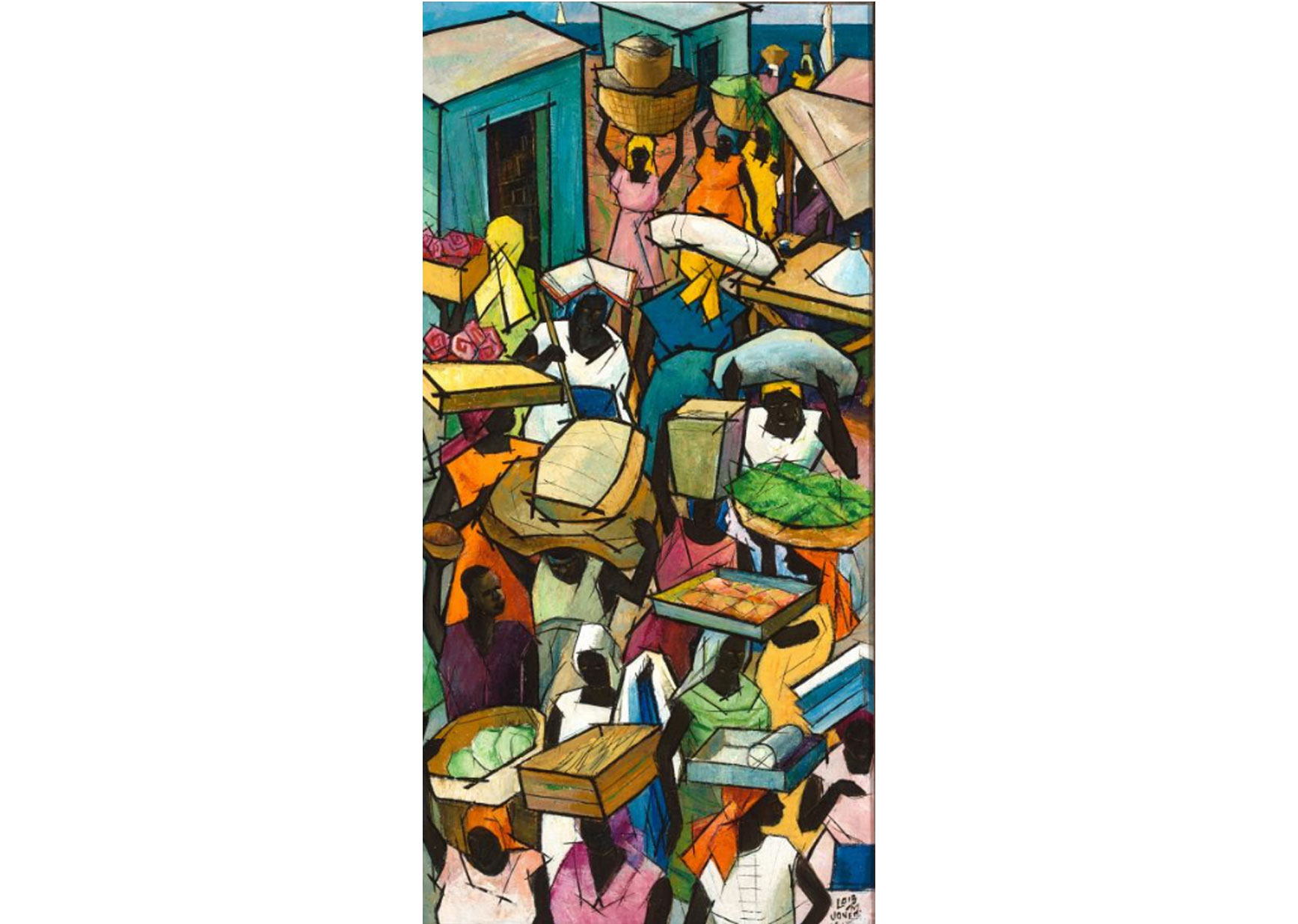This November, I had the wonderful opportunity to lead two “Inside Look” gallery talks at the Delaware Art Museum on Loïs Mailou Jones’s 1961 painting Parade de Paysans (Peasants on Parade). The painting is a recent acquisition by the museum and is representative of the institution’s commitment to acquiring works of art by women artists and artists of color. Because the pandemic prevented in-person programming this fall, the discussions took place over Zoom. Although I was initially skeptical about facilitating these talks virtually, I was pleasantly surprised at the nuanced observations and the depth of conversation that developed by closely looking at the painting. As the participants and I studied the work together, we noticed the sense of joy and movement emanating from the scene, which led to questions about Jones herself, her distinctive painting style, and her choice of subject.
Parade de Paysans depicts a Haitian market scene on a bright, sunny day. Over twenty figures populate the scene, coming to and from the market with products to sell. Most of the peasants carry their baskets, crates, and sacs on their heads, revealing an array of goods like lettuce, flowers, and bread. Two structures—likely storehouses—stand near the top of the painting. Also pictured to the right is a covered stand where peasants could set up their displays of goods. The painting probably depicts the market on Saturday, the largest and busiest market day of the week. Peasants would travel long distances from various villages to the nearest town to sell fish, grain, produce, and baked goods. Jones likely witnessed a scene like this in person, having travelled to Haiti regularly since 1954.
Museumgoers were quick to point out the painting’s vibrant colors and geometric style. For instance, they noted that the work could be read as a series of shapes, outlined by bold black lines. The work’s high horizon line and vertical format further flattens and abstracts the painting, tightly framing and pushing the scene towards the picture plane. These compositional choices allowed Jones to effectively capture the hustle and bustle of the market. One participant observed that the way in which Jones placed the figures produced a kind of rhythmic choreography, suggesting movement despite the static nature of the painting. We discussed how the figures functioned to lead the eye through the scene, beginning in the lower left corner and meandering up through the crowded market to the sea above. In general, we noted how the painting’s movement, color, and composition captured the energetic and festive nature of Haiti’s market and its peasants; we felt as if we were immersed in the scene, witnessing and listening to the sounds of the busy market.
In part, Jones’s distinctive style in Parade de Paysans is a testament to her early career as a designer. In 1927, she was the first African American student to graduate from the School of the Museum of Fine Arts, specializing in textile design. Parade de Paysans draws on Jones’s background as a designer through its abstracted shapes, bright colors, and compositional rhythm. One participant additionally identified a relationship between Jones’s style and Cubism, which she would have encountered during a nine-month visit to Paris in 1937.
Having discussed Jones’s training, we shifted to talk about the painting’s subject. After returning from Paris in 1938, Jones was encouraged to reevaluate her subject matter and to find inspiration in her African heritage. Spurred by her marriage to Haitian graphic designer Louis Pierre-Noel, Jones’s travels to Haiti played a transformative role in this decision. For Jones, Haiti served as a bridge to Africa. While there, she began painting works that more closely focused on the Black experience, drawing upon African themes, subjects, and objects. She explained that visiting the Caribbean island completely altered her style, shifting her palette to brighter and lighter colors in an attempt to capture the tropicality of the landscape and the spirit of the people. Parade de Paysans is a perfect representation of this shift.
The more we examined the painting, it became clear that Parade de Paysans was a celebration of Haiti, its people, and Jones herself. We also wondered if the work spoke more personally to the racial and gender biases she faced throughout her career. While Jones depicted a variety of peasants in Parade de Paysans, the majority of the figures are women. Perhaps Jones connected more closely with the women peasants, similarly selling her own “goods” (paintings) to make a living. Indeed, she was the breadwinner of her family, paying off Pierre-Noel’s debts and making a steady income. Jones was a true trailblazer, exhibiting her work, receiving awards, teaching, and making a name for herself as an artist despite the constant challenges she encountered as an African American woman. As we took the time to carefully look at the painting, we began to uncover the vibrancy of Jones as an artist and human.
Kristen Nassif
Ph.D. Candidate, Art History, University of Delaware
Image: Parade de Paysans (Peasants on Parade), 1961. Loïs Mailou Jones. Oil on canvas, 39 1/4 x 19 inches. Delaware Art Museum. Acquisition Fund, 2018. © Estate of Loïs Mailou Jones.

